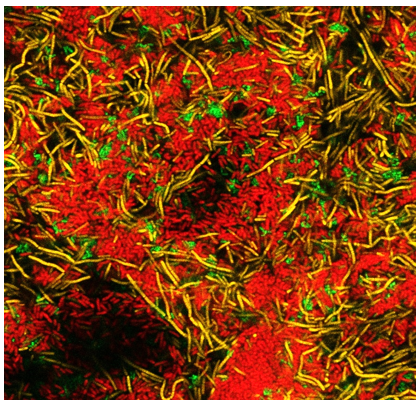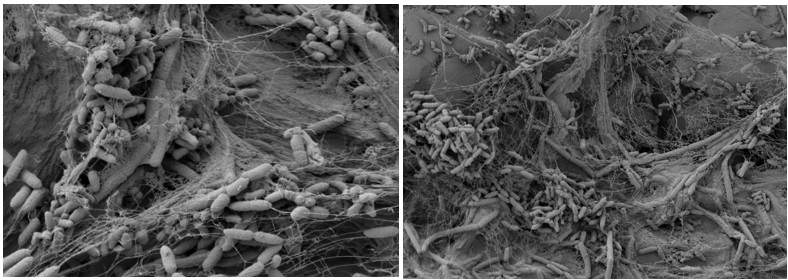Press release Complex interactions between bacterial species make biofilms persistent

According to a study in Nature Reviews Microbiology (REF 1) most of the bacteria in natural and industrial settings prefer to live together in communities, known as biofilms, that cling to a variety of biotic and abiotic surfaces. These biofilms are not just random assemblies; they are intricately organized structures where bacteria engage in human-like social interactions, marked by both cooperation and conflict. Central to their organization is the production of a protective matrix, a sticky substance that holds the communities together. This communal living offers numerous advantages to the bacteria, such as enhanced tolerance to antimicrobials and protection from harsh conditions, making them particularly challenging to eliminate in for example clinical settings and the food industry. Biofilms pose a substantial economic burden, as it is estimated that around $324 billion USD are spent annually to control and eliminate biofilms throughout the farm-to-fork process in food processing (REF 2). Understanding and disrupting these bacterial communities is therefore a key focus in both healthcare and industry to ensure safe food and hygiene.
The research institute ILVO, through the Marie Skłodowska-Curie Actions fellowship awarded to Dr. Faizan Ahmed Sadiq, initiated this project funded by the European Commission (grant ID 101025683) with the goal of enhancing our understanding of interactions within multispecies biofilms composed of several species from the dairy industry, Insights from this research will create new strategies for biofilm management in the dairy industry and by extension also on dairy farms., particularly by improving cleaning and disinfection.
What was the specific reason for this research: how significant is the problem of biofilms in dairy?
It is well-established that biofilms pose significant challenges in dairy farming and processing environments, as they can be a source of microbial contamination and infection. The temperature, humidity, and organic material in dairy processing facilities create optimal conditions for bacterial growth and biofilm formation. Biofilms in these settings can contain spoilage organisms (e.g., Bacillus species) and pathogenic bacteria like Listeria monocytogenes, necessitating regular and effective cleaning and disinfection practices to control their formation.
The primary focus of this research was to understand the interactions between different species on both food and non-food contact surfaces in the dairy industry, such as pasteurizers. The project aimed to explore the implications of these interactions on the stability and resilience of microbial communities forming multispecies biofilms such as their tolerance to the use of cleaning and disinfection chemicals during Clean-in-Place (CIP) processes. This research is crucial for developing more effective strategies to manage biofilms and ensure safety and efficiency in dairy operations.
What is the major breakthrough? What new insights have been gained?
In our project, we have discovered how a wide variety of bacterial species can form biofilms on stainless steel (REF 3). These species were found on the surface of a dairy pasteurizer even after cleaning and disinfection. In the lab we have unveiled fascinating insights into the complex social dynamics between these species within biofilm communities made by investigating a large diversity of combinations of different strains in a model system using plastic surface or coupons of stainless steel. In the intricate world of biofilms, bacterial interactions are far more than just a matter of cohabitation; they are key determinants of the community's structure, stability, and, most importantly, survival, especially when faced with antimicrobial treatments like cleaning and disinfection. For instance, the absence of a key species can make the biofilm more susceptible to disinfectants, while on the contrary the presence of another might confer enhanced tolerance. These interactions range from cooperation to competition, yet, remarkably, they coexist within the same biofilm setup, striking a delicate balance that maintains the community's overall integrity (REF 3). Another major discovery in our study is the identification of key species, like Microbacterium lacticum, which are crucial in biofilm formation at least in the dairy sector. These key species are vital for the stability and strong growth of other bacteria like Stenotrophomonas in the entire biofilm, serving as a cornerstone that keeps the complex web of microbial interactions intact. This finding has shifted our traditional understanding of biofilms based on single species and opens up new ways of looking at how mixed-species communities manage to flourish together, even amidst potential conflicts.
What does this mean for the sector, can it already be translated into concrete guidelines?
These findings provide a deeper understanding of microbial ecology and could inform future strategies for managing biofilms in various settings such as farms and food industry. By unravelling and interfering with the complex interactions within these microbial communities, we could unlock the door to developing more potent antimicrobial strategies that target their social interdependence. It seems already useful to monitor the level of the key species Microbacterium lacticum in the dairy processing environment as a warning light for possible biofilm problems.
This includes examining the interplay between spore-forming and non-spore-forming bacteria, such as interactions between Bacillus and Stenotrophomonas species, and determining how these interactions influence biofilm stability and integrity in the face of cleaning and disinfection treatment.
Why was it so special that we had a Marie Skłodowska-Curie fellowship about this?
For ILVO, the Marie Skłodowska-Curie fellowship, the first one at our institute,made it possible to hire a top post doc scientist who was very experienced in biofilm research abroad, and eager to expand his scientific and transferable skills. The “Multispeciesbiofilm" fellowship highlights a landmark in biofilm research in the dairy sector, by also fostering a strong collaboration between ILVO and research groups atKU Leuven, and the University of Copenhagen where the post doc scientist performed specialized measurements. This partnership not only advances scientific understanding but also opens new avenues for future research collaborations, blending diverse expertise to tackle complex challenges in food safety and biofilm dynamics.The support from the Marie Skłodowska -Curie fellowship for such an innovative and multidisciplinary approach, involving techniques like metatranscriptomics and confocal laser scanning microscopy and the use of biosensors, marks a significant advancement in the field of biofilm research, with potential implications for enhancing food safety and quality in the dairy industry and beyond.
The project's significance is further underscored by the context of the dairy industry, one of Europe's largest food manufacturing sectors, where stainless steel surfaces are prone to biofilm formation. Prior studies have mostly focused on single or dual species biofilms, but this project emphasizes the importance of understanding multispecies interactions, which are fundamental for studying biofilm community structure, spatial organization, and the underlying factors of biofilm formation.
Are there any further plans with this research – how will it proceed?
Building on the insights gained from the 'Multispeciesbiofilm' project, a running project will go deeper in understanding of interspecies interactions in biofilms in drinking water pipelines of poultry and pig farms, with the aim to improve drinking water quality for the animals through optimized cleaning and disinfection protocols and water treatments. Further plans also involve exploring more effective strategies for biofilm management, particularly in the dairy industry. We aim to translate our findings into practical applications, potentially testing new chemicals and developing new cleaning and disinfection protocols that target keystone species and social interactions. On a more fundamental basis, it would be interesting to study evolutionary aspects of these interactions in a biofilm setup. Additionally, the strong collaboration established among ILVO, KU Leuven, and the University of Copenhagen sets the stage for continued joint research efforts, focusing on innovative solutions to enhance food safety and quality.
References
- Bacteria and archaea on Earth and their abundance in biofilms | Nature Reviews Microbiology
- Translational challenges and opportunities in biofilm science: a BRIEF for the future | npj Biofilms and Microbiomes (nature.com)
- Frontiers | Synergistic interactions in multispecies biofilm combinations of bacterial isolates recovered from diverse food processing industries (frontiersin.org)
- Dynamic social interactions and keystone species shape the diversity and stability of mixed-species biofilms – an example from dairy isolates | ISME Communications (nature.com)
Images



This project has received funding from the European Union’s Horizon 2020 research and innovation programme under the Marie Sklodowska-Curie grant agreement No 101025683.
Disclaimer
The results and conclusions in this presentation reflect only the authors’ view. The funding Research Executive Agency (REA), delegated by the European Commission, is not responsible for any use that may be made of the information it contains.
We combineerden voor het eerst technieken zoals metatranscriptomics, confocal laser scanning microscopy en het gebruik van biosensoren op combinaties van bacteriesoorten, wat een grote vooruitgang betekende voor het onderzoek naar biofilms.
Meer info
Lees een langer artikel met link naar de verschillende wetenschappelijke publicaties, in het Engels.

This project has received funding from the European Union’s Horizon 2020 research and innovation programme under the Marie Sklodowska-Curie grant agreement No 101025683.
Disclaimer
The results and conclusions in this presentation reflect only the authors’ view. The funding Research Executive Agency (REA), delegated by the European Commission, is not responsible for any use that may be made of the information it contains.